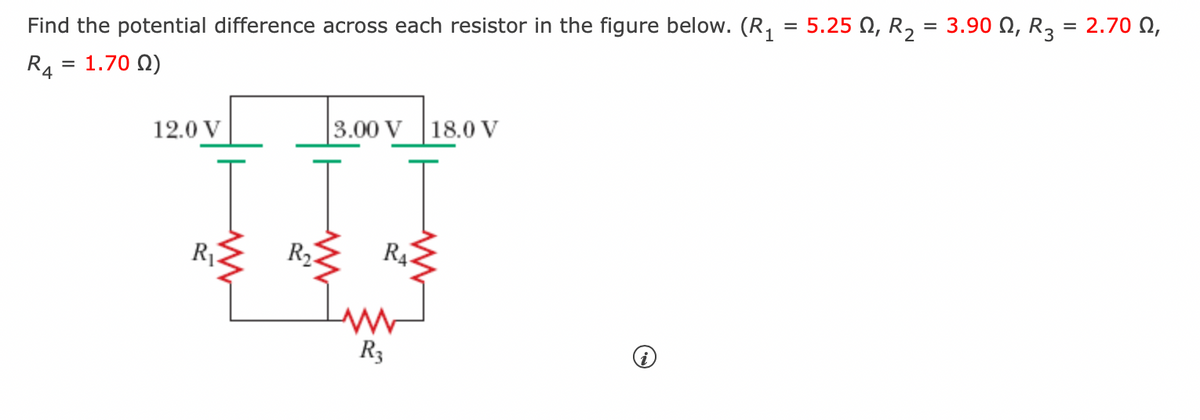Find the potential difference across each resistor in the figure below. (R₁ = 5.25 №, R₂ = 3.900, R3 = 2.700, R4 = 1.700) 12.0 V 3.00 V I I I 18.0 V R3 i
Find the potential difference across each resistor in the figure below. (R₁ = 5.25 №, R₂ = 3.900, R3 = 2.700, R4 = 1.700) 12.0 V 3.00 V I I I 18.0 V R3 i
Physics for Scientists and Engineers, Technology Update (No access codes included)
9th Edition
ISBN:9781305116399
Author:Raymond A. Serway, John W. Jewett
Publisher:Raymond A. Serway, John W. Jewett
Chapter28: Direct-current Circuits
Section: Chapter Questions
Problem 28.21P: Consider the circuit shown in Figure P28.21 on page 860. (a) Find the voltage across the 3.00-0...
Related questions
Question
27.15
fill in the blanks
and finding the potential difference across each resistor

Transcribed Image Text:Find the potential difference across each resistor in the figure below. (R₁
R₁ = 1.700)
12.0 V
R₁
R₂-
3.00 V 18.0 V
RA
R3
=
5.250, R₂
=
3.900, R3 = 2.700,
![Assume that the currents I₁, I2, and I3 are in the directions indicated by the arrows in the figure redrawn below.
(Enter your answers to at least four significant figures.)
a 1₂2
12.0 V
R₁
or
Solving for I₁ gives
1
R₂.
3.00 V
0
Im
R3
Applying Kirchhoff's junction rule at a gives
13 = 1₁ + 1₂.
[1]
Using Kirchhoff's loop rule starting at point a and going clockwise around the leftmost loop yields
RA
18.0 V
I
-3.00 V - R₂13 - R₁₁ + 12.0 V = 0.
X
0
I₁
= The correct answer is not zero. V
R₁
- (R₁)131
1₁
= The correct answer is not zero. A
A) - (0
The correct answer is not zero.
.)13. [2]
3'
X](/v2/_next/image?url=https%3A%2F%2Fcontent.bartleby.com%2Fqna-images%2Fquestion%2F21e8a523-579f-40b9-8f0a-805524283a8d%2F20effa46-841d-4b30-922a-34de1079cd73%2F754xxnq_processed.png&w=3840&q=75)
Transcribed Image Text:Assume that the currents I₁, I2, and I3 are in the directions indicated by the arrows in the figure redrawn below.
(Enter your answers to at least four significant figures.)
a 1₂2
12.0 V
R₁
or
Solving for I₁ gives
1
R₂.
3.00 V
0
Im
R3
Applying Kirchhoff's junction rule at a gives
13 = 1₁ + 1₂.
[1]
Using Kirchhoff's loop rule starting at point a and going clockwise around the leftmost loop yields
RA
18.0 V
I
-3.00 V - R₂13 - R₁₁ + 12.0 V = 0.
X
0
I₁
= The correct answer is not zero. V
R₁
- (R₁)131
1₁
= The correct answer is not zero. A
A) - (0
The correct answer is not zero.
.)13. [2]
3'
X
Expert Solution
This question has been solved!
Explore an expertly crafted, step-by-step solution for a thorough understanding of key concepts.
This is a popular solution!
Trending now
This is a popular solution!
Step by step
Solved in 3 steps with 3 images

Knowledge Booster
Learn more about
Need a deep-dive on the concept behind this application? Look no further. Learn more about this topic, physics and related others by exploring similar questions and additional content below.Recommended textbooks for you

Physics for Scientists and Engineers, Technology …
Physics
ISBN:
9781305116399
Author:
Raymond A. Serway, John W. Jewett
Publisher:
Cengage Learning

Physics for Scientists and Engineers: Foundations…
Physics
ISBN:
9781133939146
Author:
Katz, Debora M.
Publisher:
Cengage Learning

Principles of Physics: A Calculus-Based Text
Physics
ISBN:
9781133104261
Author:
Raymond A. Serway, John W. Jewett
Publisher:
Cengage Learning

Physics for Scientists and Engineers, Technology …
Physics
ISBN:
9781305116399
Author:
Raymond A. Serway, John W. Jewett
Publisher:
Cengage Learning

Physics for Scientists and Engineers: Foundations…
Physics
ISBN:
9781133939146
Author:
Katz, Debora M.
Publisher:
Cengage Learning

Principles of Physics: A Calculus-Based Text
Physics
ISBN:
9781133104261
Author:
Raymond A. Serway, John W. Jewett
Publisher:
Cengage Learning